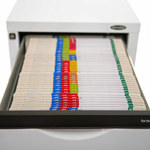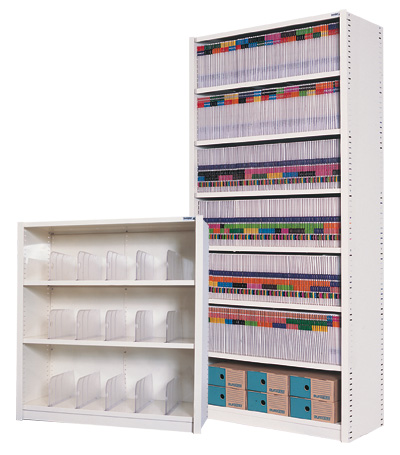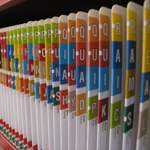Managing space
With real estate costs rising in pace with business growth, many organizations are forced to house more people, operations and equipment in less space. The problem is especially acute for records management professionals, as growing business means growth in business records.
Today more than ever before, effective records management must play a central role in the cost efficient design and use of available floor space. The records management industry has responded to this growing trend with filing equipment and supplies which can store more records using less total floor space.
Here are just some of the filing solutions that can help an organization make more efficient use of storage space:

• Tabtop/ Drawer Filing: More traditional vertical filing arranges files from front to back in a pull out drawer. A four foot deep vertical file cabinet requires an additional four feet of floor space at the front to accommodate the pull out. Lateral filing avoids this problem by arranging files from left to right, reducing the necessary clearance space to the length of one file folder. When lateral filing is combined with a lateral folder design, the clearance space drops to zero, As file labels can be read and folders removed without a pull-out drawer or shelf.

• Mobile vs. Static Shelving: Mobile shelving systems are equipped with rollers which sit on tracks in the floor. Instead of one aisle for every two rows of static shelving, a mobile solution can function with as little as one aisle, which users move to access files in a given row. Less aisles means either less total floor space needed to store the same volume of files, or more storage potential in the same space.

• Lateral/ Shelf filing: file folders are designed to hold labels on the side rather than the protruding top tab of more traditional folders. File can sit upright in either open faced cabinets or shelving, eliminating the need for pull out drawers and bulky hanging folders. Also, without the protruding top tab, lateral folders are shorter (in height), allowing the filing system to stack more usable rows of shelving on the same square footage of floor space. Finally, because it is not necessary to have the top of the folder at eye level, lateral labels allow files to be stored at a higher position while still keeping label information readable.
Tabtop, mobile shelving, and Lateral filing solutions can have a dramatic impact on space Utilization, but their full potential is realized once they are combined with a colour-coded filing solution. Colour coding can certainly be useful for tabtop filing and vertical storage, but its design is especially well suited to lateral solutions, helping users to read retrieval information without removing files from the shelves.
While lateral files alone increase the number of filing rows readable from a normal standing position, that visibility range is increased further still by colour Coding. A colour-coded lateral solution can allow as many as seven easily usable filing rows. As a key component of an integrated storage solution, colour coding can help improve overall space utilization.
